The New Taichung City Civic Center
International Competition
Architects: Celestino Soddu, Enrica Colabella
Collaboration team: F.Piccarreta, P.Carchedi, A.Caroppo, R.De Benedictis, A.Monti,
R.Pietra, M.Pizzini
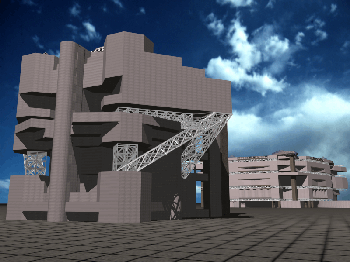 DESIGN CONCEPT
DESIGN CONCEPT
The global approach to the design of The New
Taichung City Civic Center.
The challenge of our project is to characterise and increase the
identity in progress of Taichung City.
To achieve this objective, we have organised a design approach
able to control the complexity of the natural and artificial
environment.
We aim to build a town environment based on the chineese
traditions and, in the same time, looking to the future, to the
new century.
A beautiful town is a town with a characterised identity and with
a stratified complexity. We begin to design the park system as
an urban environment for increasing the identity. We want to
build an unique site that follows and enlarges the dynamic
evolution of this town.
Our objective is to build a new urban microsystem that represents
the culture of Taiwan and also its dynamic evolution. The park
system and the two buildings must be the image of one of the four
little dragons of Asia.
To achieve that, we designed two great events, two
architectures, the City Council and The City Government. We
adopted this choice in front of the consideration that a large
and well identifiable building is more interesting for the
increasing identity of an urban environment.
Concerning the parks, we adopted the traditional approach
stratifying, in this natural/artificial, a multiplicity of
possible paths of multiple discoveries.
The park is a natural green environment for the use of
Government, but also for all the people of Taiwan, especially for
the children.
The Taichung City Government Building
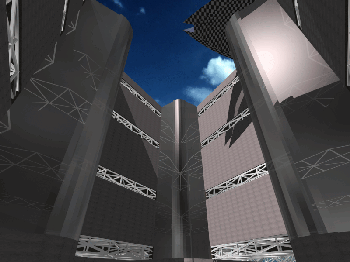 1. Image and Characterisation.
1. Image and Characterisation.
This building is organised following the North-South axis, and
appears in front of the street that come from South. It is
structured, on ground level, with a floor opened to the park with
a glass gallery, an interface between parks and the building.
The building is identifiable with its particular shape, based on
a complex geometry that starts from an octagon with, overside,
the rounder shape of the Major office that looks to the South.
This image seems the head of a dragon.
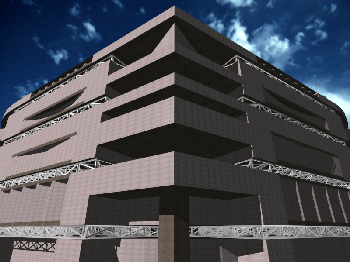 2. Functional and Structural Organisation.
2. Functional and Structural Organisation.
The building is m.80 high, jointed following the department's
identities and differences. There is, on the top level, the
office of the Major.
The underground level is used for the covered parking, stratified
in two levels. We can arrive to this parking directly with the
elevators of the building.
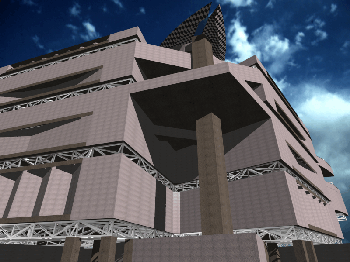 The structure of these buildings follows the need to identify the
differences. It is organised with two structure levels. The first
level, realised with large steel spatial structures, redefines
the large multifloor blocks of departments.
The structure of these buildings follows the need to identify the
differences. It is organised with two structure levels. The first
level, realised with large steel spatial structures, redefines
the large multifloor blocks of departments.
The second level is
the secondary steel structure of each department, depending upon
the first one or, if it is necessary to gain more large open
spaces, linked to the hanging over large spatial steel structure.
 This choice allows us to gain the recognisability of each
department, and the autonomy of functional organisation inside
each of them without deny the identity and recognisability of the
This structure of differences is increased also with the
different treatment of the some interior and exterior walls, on
each department.
This choice allows us to gain the recognisability of each
department, and the autonomy of functional organisation inside
each of them without deny the identity and recognisability of the
This structure of differences is increased also with the
different treatment of the some interior and exterior walls, on
each department.
Moreover, The building is organised with four blocks for the
"normal" spaces of the department functions and four corners used
for the "exceptional" spaces as particular needs of a specific
department. With this organisation we can increase the explicit
order, the characterisation and the identification signs system
of this building.
The Taichung City Council Building
 The City Council is organised as an unique building, m.87 high.
At the ground floor there is a large hall with a glass curtain
surrounded by the park. The hall is six floors high, beginning
from the underground level to the fourth floor level. Four
floors, with the library and others people services, looks out on
this hall.
The City Council is organised as an unique building, m.87 high.
At the ground floor there is a large hall with a glass curtain
surrounded by the park. The hall is six floors high, beginning
from the underground level to the fourth floor level. Four
floors, with the library and others people services, looks out on
this hall.
We arrive in the underground level with a large staircase, with a
fountain on side, and we find, in this space, the people services
and the entrance to the underground parking.
 From six to eight floor there is the auditorium and cafeteria
with the connected services. From the 9 to the top level there
is, in sequence, the lobby with the facilities, the medium and
the assembly hall with all around the connected services and the
councilors and councilors study rooms.
From six to eight floor there is the auditorium and cafeteria
with the connected services. From the 9 to the top level there
is, in sequence, the lobby with the facilities, the medium and
the assembly hall with all around the connected services and the
councilors and councilors study rooms.
On the top of the building the cupola of the assembly hall and
the speaker office with its services and secretariat.
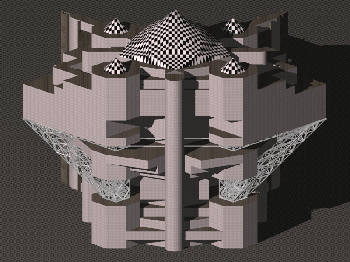 The structure of this building is organised with a pentagon
geometry in the centre, in front of the need of large spaces, and
with an octagon geometry surrounding the pentagon, organising the
structure of the connected spaces. The councilors studies and
offices are shaped as two wings, on the right and left side of
the assembly halls and lobby, with a getting out spatial steel
structure that built a characterised image for the City Council
Architecture.
The structure of this building is organised with a pentagon
geometry in the centre, in front of the need of large spaces, and
with an octagon geometry surrounding the pentagon, organising the
structure of the connected spaces. The councilors studies and
offices are shaped as two wings, on the right and left side of
the assembly halls and lobby, with a getting out spatial steel
structure that built a characterised image for the City Council
Architecture.
The structure of the buildings
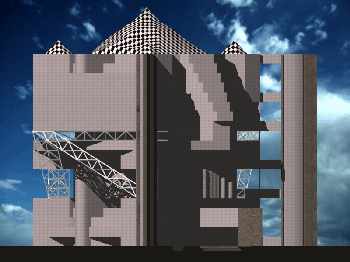 Both buildings, the City Council and the City Government
buildings, presents an entirely steel structure.
The structure is designed with big bored columns, shaped with a
sequence of four column, and linked one another at different
quotes with horizontal spatial trusses. These trusses are located
in the technical floors and support, with columns and wrangling
elements the different floors. In the vertical facades the
columns are linked with structure against wind.
Both buildings, the City Council and the City Government
buildings, presents an entirely steel structure.
The structure is designed with big bored columns, shaped with a
sequence of four column, and linked one another at different
quotes with horizontal spatial trusses. These trusses are located
in the technical floors and support, with columns and wrangling
elements the different floors. In the vertical facades the
columns are linked with structure against wind.
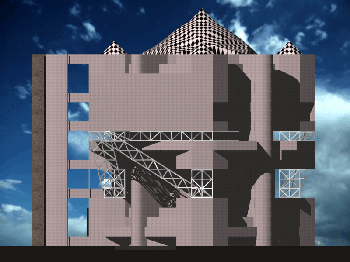
Foundations are designed with enforced concret slabs, one for
every group of four columns, with foundation piers.
The principal actions we have considered in our project are: 1.
the overload belonging the use for offices, 2. The action of
wind, 3. The thermical variations.
The City Government Building is realised with four buildings with
a rectangular plan, and with four towers in the intersection
between the buildings.
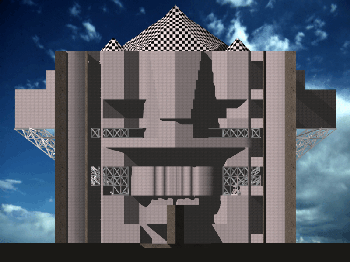
Every building is supported with groups of four columns and there
are four spatial horizontal structures.
Among the buildings are located the vertical joints to get a free
movement concerning the therminal variations.
plan. on the half of the height, the structure of the building
expand itself with a bound if25 meters.
The structure is
organised with eight groups of columns linked with the spatial
horizontal trusses and with the structures against wind actions.
The two bound elements are supported with opposite cantilevering
beams v-formed, the control the tensile and compressive stresses,
getting to the columns only the vertical loads.
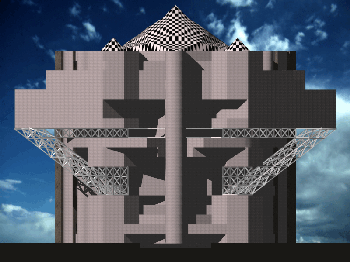 Building Technology and materials
Building Technology and materials
 The curtainwall system proposed for this project is entirely
prefabricated in the factory (inside Taiwan) prior to
installation.This method of construction is highly advantageous
because of the following:Good quality control of the fabrication
work, streamlined operation and high productivity, reduce wastage
of component materials, good control of production schedule.All
of the above contributes to a cost savings.Shop fabrication also
ensures that all the sealant and caulking work required for the
curtain wall panels is done properly and inspection of the
integrity of the seals may be carried out easily.
The curtainwall system proposed for this project is entirely
prefabricated in the factory (inside Taiwan) prior to
installation.This method of construction is highly advantageous
because of the following:Good quality control of the fabrication
work, streamlined operation and high productivity, reduce wastage
of component materials, good control of production schedule.All
of the above contributes to a cost savings.Shop fabrication also
ensures that all the sealant and caulking work required for the
curtain wall panels is done properly and inspection of the
integrity of the seals may be carried out easily.
 The design of the curtainwall system is such that there is only one field seal
to be carried out at the joint sleeve which is located at the
point where the corners of 4 curtainwall panels meet.The mullion
is designed as a coupling section, and it comprises of two
sections, known as the male and female mullion.The design of the
sections create a chamber with pressure equal to the pressure of
the external atmosphere (pressure equalised system).
The design of the curtainwall system is such that there is only one field seal
to be carried out at the joint sleeve which is located at the
point where the corners of 4 curtainwall panels meet.The mullion
is designed as a coupling section, and it comprises of two
sections, known as the male and female mullion.The design of the
sections create a chamber with pressure equal to the pressure of
the external atmosphere (pressure equalised system).
Thus
preventing the penetration of water that, hence, is channelled
downwards as there is no force to push the water into the
building.
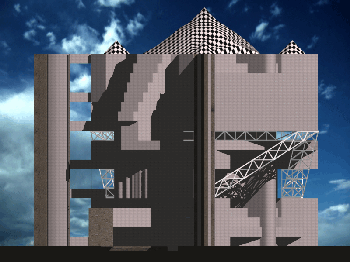 Gaskets are used at the mating zones to separate the
pressure equalised chamber from the exterior.The curtainwall
panels are attached to the building superstructure by means of
galvanised anchor brackets (one number per panel in most cases)
and Halfen channel embedded in concrete.The anchor bracket is
fixed to the pane
Gaskets are used at the mating zones to separate the
pressure equalised chamber from the exterior.The curtainwall
panels are attached to the building superstructure by means of
galvanised anchor brackets (one number per panel in most cases)
and Halfen channel embedded in concrete.The anchor bracket is
fixed to the pane
This set-up allows the individual panel to rotate
about a single point, thus absorbing any building movements due
to the thermal expansion contraction, seismic loads or slab
deflections due to loading.
 The anchorage system also provides a
much greater degree of movement than conventional systems in
which the panels are attached to the superstructure at two or
more points.
The anchorage system also provides a
much greater degree of movement than conventional systems in
which the panels are attached to the superstructure at two or
more points.
The granite panels and the blind areas, such as the
spandrel section of this curtainwall, are designed as ventilated
panels.The chamber between the rear of the granite or the
spandrel glass/aluminium panel and the insulated panel is linked
to the external by means of slot holes in the transom framing
members.Other technical characteristics of the curtain
wall:Earthquake proof.
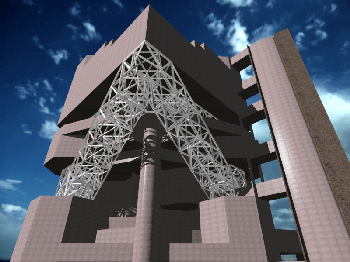 The panel system is earthquake proof due
to the telescoping joints, both horizontally and vertically,
isolated by gaskets in neoprene EPDM, able to absorb expansions
of +/- 10 mm, for a total of 20 mm.Thermal interruption obtained
due to the elimination of external conductivity through the
exposition of the aluminium mass interior = 10%.The openings
(invisible from both internal and external viewpoints) for double
ventilation.Waterproof barrier between floors.
The panel system is earthquake proof due
to the telescoping joints, both horizontally and vertically,
isolated by gaskets in neoprene EPDM, able to absorb expansions
of +/- 10 mm, for a total of 20 mm.Thermal interruption obtained
due to the elimination of external conductivity through the
exposition of the aluminium mass interior = 10%.The openings
(invisible from both internal and external viewpoints) for double
ventilation.Waterproof barrier between floors.
This allows for an
absolutely independent seal for each floor so that in case of
flooding water, is drained to the exterior of the building
washing system. The tie-ins can be incorporated in the curtain
wall system and be exteriorly invisible.

The Parks
 We have organised the park system in respect of the ancient
technical of Feng Shui.
We have organised the park system in respect of the ancient
technical of Feng Shui.
We have designed the natural environment divided into three
gardens. The area 1-1, near the City Government building is
called "The Rain Garden", the area 1-2,2-2,2-1, expanded in the
area 2-3 and into the area 1, under the City Government building
till the area 2, under the City Council Building, is called "The
Garden of Pomegranates tree", and the last one, area 1-3,
connected with a bridge with the area 2, is called "The Garden of
the green Dragon".
The parks are subdivided into many scenic sections to create
the impression of spaciousness , an enchanting constructed and
thematic environment.
The centrally located main section and the surrounding
subordinate sections are characterised by different themes.
Every garden scene has its own point of interest (a tower, a
pavilion, a mountain, etc) to give originality and individuality,
but at the same time the park is unified by the theme of
prosperity and by water.
Each construction in the garden has a double function: as a
scenic spot for static viewing and as a point of interest from
other dynamic viewing points.
The dynamic viewing points are located along the paths and the
walking galleries giving different vistas during a touring
route. Static and dynamic viewing are the basis of the planned
organisation.
Hills and water have taken priority in the process of structuring
the landscape. Artificial hills are shaped to simulate the
distilled and enhanced beauty of natural mountain views creating
peaks, cliffs, precipices, ravines, gorges and caves.
Water is the element of conjunction of the park. Its composition
undulating lines and forms derived from nature.
Garden architecture is another important element of the garden.
The main hall occupies a key position in the center of the park
as a center of activities .
It is south oriented and located in a position to command the
dominating garden scene.
Pavilions of different sizes and forms are distributed
throughout the park. They represent a pause during walking.
They are a visual attraction and at the same time serve as
sheltered vantage point commanding views in all directions. They
are located on the hillside, on the stream and near the forest.
The walking galleries are the connections between the different
garden buildings. They divide and at the same time unite the
scenic sections, greatly adding to the depth and sequence of the
garden views.
The parks can be walked through in three different ways. The
most direct paths cross the park longitudinally through parallel
arcades. The second way is the main touring route, thought of as
a fast and covered path. The last path is the slowest and most
winding which connects all garden architectures situated along
the stream.
The Rain Garden is near the City Government .It is symbol of
richness and success.
It is limited by Taichung Harbor road. It is organised with six
pavilion of facilities and one main hall named The main Hall of
the White TIger.Inside we have a small hill of 5 m. one only
great pond, one walking gallery, two way street of access at the
City Government We define two scenic section;one concerning the
main hall of white tiger and the other concerning the City
Government The garden of the pomegranates tree is a pleasure
garden characterised by a big tree planted in the courtyard of
the main hall, not only for its spectacular fruits, but also as
an auspicious symbol of prosperity. Inside we have the main hall
of pomegranates tree;formalised by an octagon,the lake of CH'J,
many ponds,two walking galleries, two great hills, two little
hills, ten pavilions for facilities. There are three different
scenic section. The garden of the Green Dragon is between Shin-
ien road and Shin-jen N.1st Road. It is linked to the City
Council by a bridge. The main hall is called of Black Turtle.
This is a fractal building of The City Council. We have one
double pavilions named Red Phoenix, two little hills, two
walking galleries, three ponds,one bridge.
The Autors
Bibliography
Return to the first page
Mail to Prof. Celestino Soddu
Mail to Prof. Enrica Colabella

 DESIGN CONCEPT
DESIGN CONCEPT 1. Image and Characterisation.
1. Image and Characterisation. 2. Functional and Structural Organisation.
2. Functional and Structural Organisation. The structure of these buildings follows the need to identify the
differences. It is organised with two structure levels. The first
level, realised with large steel spatial structures, redefines
the large multifloor blocks of departments.
The structure of these buildings follows the need to identify the
differences. It is organised with two structure levels. The first
level, realised with large steel spatial structures, redefines
the large multifloor blocks of departments. This choice allows us to gain the recognisability of each
department, and the autonomy of functional organisation inside
each of them without deny the identity and recognisability of the
This structure of differences is increased also with the
different treatment of the some interior and exterior walls, on
each department.
This choice allows us to gain the recognisability of each
department, and the autonomy of functional organisation inside
each of them without deny the identity and recognisability of the
This structure of differences is increased also with the
different treatment of the some interior and exterior walls, on
each department. The City Council is organised as an unique building, m.87 high.
At the ground floor there is a large hall with a glass curtain
surrounded by the park. The hall is six floors high, beginning
from the underground level to the fourth floor level. Four
floors, with the library and others people services, looks out on
this hall.
The City Council is organised as an unique building, m.87 high.
At the ground floor there is a large hall with a glass curtain
surrounded by the park. The hall is six floors high, beginning
from the underground level to the fourth floor level. Four
floors, with the library and others people services, looks out on
this hall. From six to eight floor there is the auditorium and cafeteria
with the connected services. From the 9 to the top level there
is, in sequence, the lobby with the facilities, the medium and
the assembly hall with all around the connected services and the
councilors and councilors study rooms.
From six to eight floor there is the auditorium and cafeteria
with the connected services. From the 9 to the top level there
is, in sequence, the lobby with the facilities, the medium and
the assembly hall with all around the connected services and the
councilors and councilors study rooms. The structure of this building is organised with a pentagon
geometry in the centre, in front of the need of large spaces, and
with an octagon geometry surrounding the pentagon, organising the
structure of the connected spaces. The councilors studies and
offices are shaped as two wings, on the right and left side of
the assembly halls and lobby, with a getting out spatial steel
structure that built a characterised image for the City Council
Architecture.
The structure of this building is organised with a pentagon
geometry in the centre, in front of the need of large spaces, and
with an octagon geometry surrounding the pentagon, organising the
structure of the connected spaces. The councilors studies and
offices are shaped as two wings, on the right and left side of
the assembly halls and lobby, with a getting out spatial steel
structure that built a characterised image for the City Council
Architecture. Both buildings, the City Council and the City Government
buildings, presents an entirely steel structure.
The structure is designed with big bored columns, shaped with a
sequence of four column, and linked one another at different
quotes with horizontal spatial trusses. These trusses are located
in the technical floors and support, with columns and wrangling
elements the different floors. In the vertical facades the
columns are linked with structure against wind.
Both buildings, the City Council and the City Government
buildings, presents an entirely steel structure.
The structure is designed with big bored columns, shaped with a
sequence of four column, and linked one another at different
quotes with horizontal spatial trusses. These trusses are located
in the technical floors and support, with columns and wrangling
elements the different floors. In the vertical facades the
columns are linked with structure against wind.

 Building Technology and materials
Building Technology and materials The curtainwall system proposed for this project is entirely
prefabricated in the factory (inside Taiwan) prior to
installation.This method of construction is highly advantageous
because of the following:Good quality control of the fabrication
work, streamlined operation and high productivity, reduce wastage
of component materials, good control of production schedule.All
of the above contributes to a cost savings.Shop fabrication also
ensures that all the sealant and caulking work required for the
curtain wall panels is done properly and inspection of the
integrity of the seals may be carried out easily.
The curtainwall system proposed for this project is entirely
prefabricated in the factory (inside Taiwan) prior to
installation.This method of construction is highly advantageous
because of the following:Good quality control of the fabrication
work, streamlined operation and high productivity, reduce wastage
of component materials, good control of production schedule.All
of the above contributes to a cost savings.Shop fabrication also
ensures that all the sealant and caulking work required for the
curtain wall panels is done properly and inspection of the
integrity of the seals may be carried out easily. The design of the curtainwall system is such that there is only one field seal
to be carried out at the joint sleeve which is located at the
point where the corners of 4 curtainwall panels meet.The mullion
is designed as a coupling section, and it comprises of two
sections, known as the male and female mullion.The design of the
sections create a chamber with pressure equal to the pressure of
the external atmosphere (pressure equalised system).
The design of the curtainwall system is such that there is only one field seal
to be carried out at the joint sleeve which is located at the
point where the corners of 4 curtainwall panels meet.The mullion
is designed as a coupling section, and it comprises of two
sections, known as the male and female mullion.The design of the
sections create a chamber with pressure equal to the pressure of
the external atmosphere (pressure equalised system). Gaskets are used at the mating zones to separate the
pressure equalised chamber from the exterior.The curtainwall
panels are attached to the building superstructure by means of
galvanised anchor brackets (one number per panel in most cases)
and Halfen channel embedded in concrete.The anchor bracket is
fixed to the pane
Gaskets are used at the mating zones to separate the
pressure equalised chamber from the exterior.The curtainwall
panels are attached to the building superstructure by means of
galvanised anchor brackets (one number per panel in most cases)
and Halfen channel embedded in concrete.The anchor bracket is
fixed to the pane The anchorage system also provides a
much greater degree of movement than conventional systems in
which the panels are attached to the superstructure at two or
more points.
The anchorage system also provides a
much greater degree of movement than conventional systems in
which the panels are attached to the superstructure at two or
more points. The panel system is earthquake proof due
to the telescoping joints, both horizontally and vertically,
isolated by gaskets in neoprene EPDM, able to absorb expansions
of +/- 10 mm, for a total of 20 mm.Thermal interruption obtained
due to the elimination of external conductivity through the
exposition of the aluminium mass interior = 10%.The openings
(invisible from both internal and external viewpoints) for double
ventilation.Waterproof barrier between floors.
The panel system is earthquake proof due
to the telescoping joints, both horizontally and vertically,
isolated by gaskets in neoprene EPDM, able to absorb expansions
of +/- 10 mm, for a total of 20 mm.Thermal interruption obtained
due to the elimination of external conductivity through the
exposition of the aluminium mass interior = 10%.The openings
(invisible from both internal and external viewpoints) for double
ventilation.Waterproof barrier between floors.
